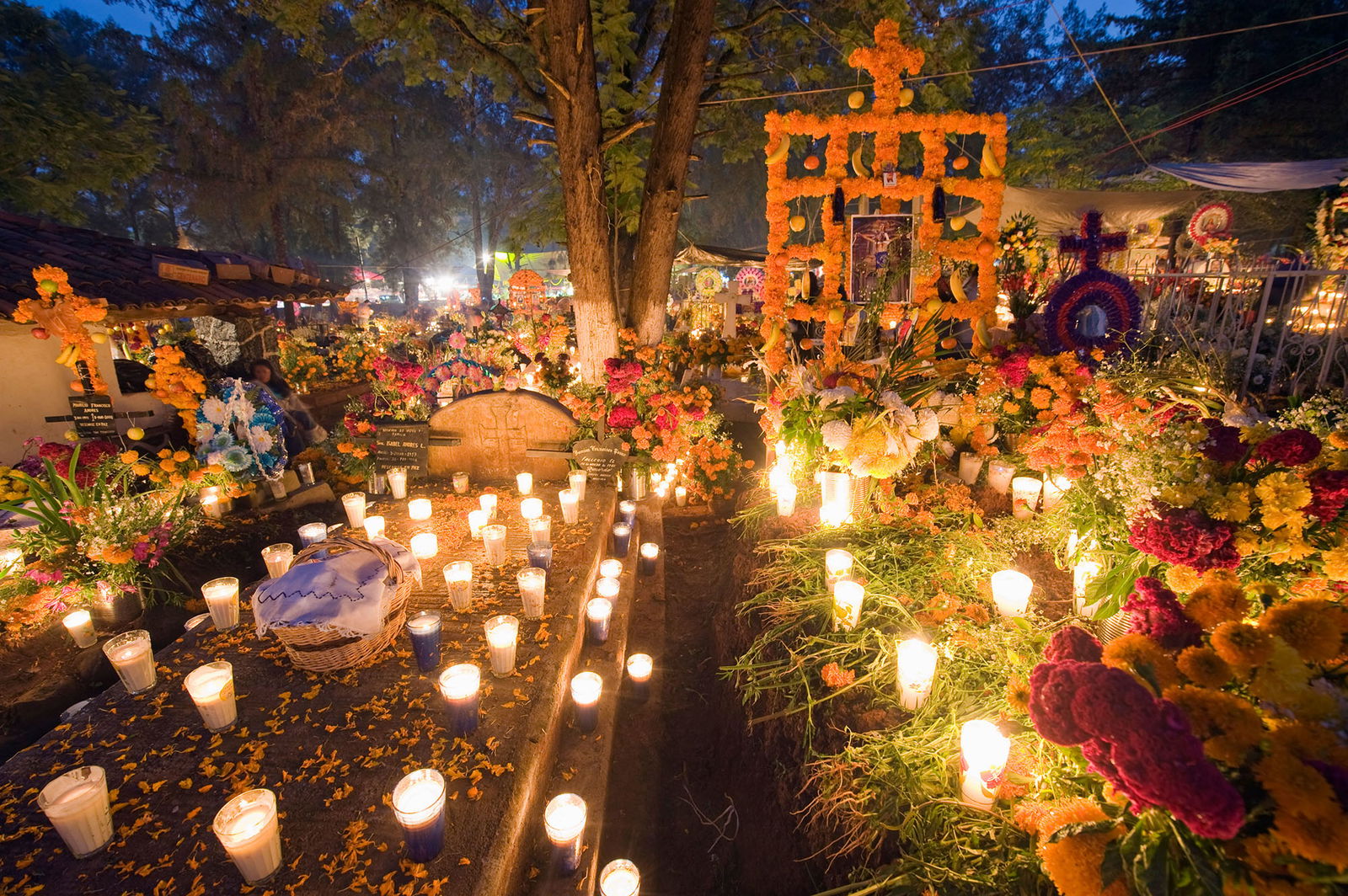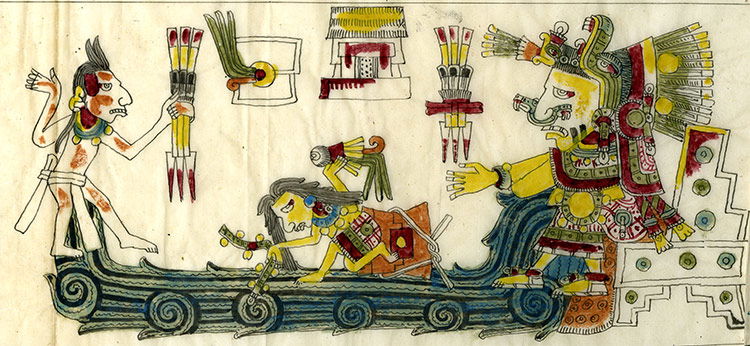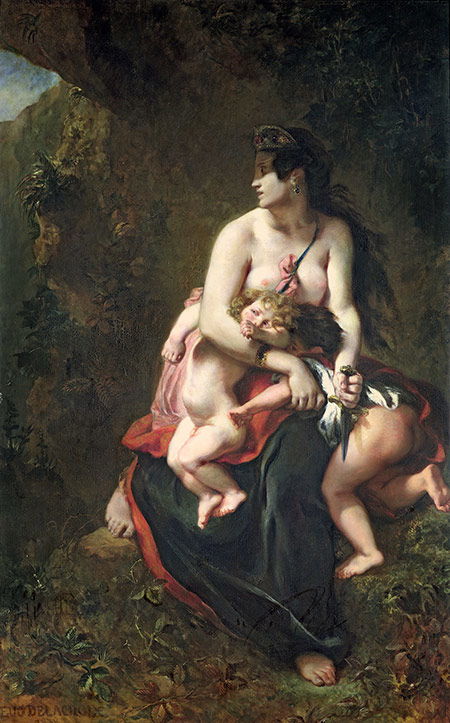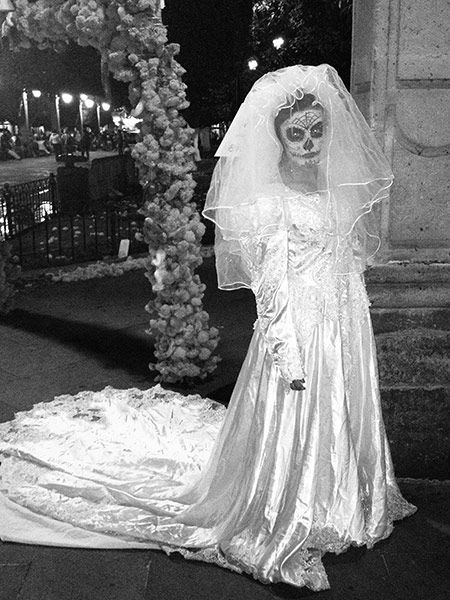The Origin of La Llarona
The legend of La Llorona has supposedly haunted Mexico since before the Conquest. The wailing woman’s story is one of violence, much like the country whose suffering she is often taken to represent. Beware the woman in white ...

A candlelit cemetery on the Day of the Dead, Tzintzuntzan, Mexico, 2010.
A Mexican woman, Juana Léija, attempted to kill her seven children by throwing them into the Buffalo Bayou in Houston, Texas in 1986. A victim of domestic violence, she was apparently trying to end her suffering and that of her children, two of whom died. During an interview Léija declared that she was La Llorona.
La Llorona is a legendary figure with various incarnations. Usually translated into English as ‘the wailing woman’, she is often presented as a banshee-type: an apparition of a woman dressed in white, often found by lakes or rivers, sometimes at crossroads, who cries into the night for her lost children, whom she has killed. The infanticide is sometimes carried out with a knife or dagger, but very often the children have been drowned. Her crime is usually committed in a fit of madness after having found out about an unfaithful lover or husband who leaves her to marry a woman of higher status. After realising what she has done, she usually kills herself. She is often described as a lost soul, doomed to wander the earth forever. To some she is a bogeywoman, used by parents to scare children into good behaviour.
This folk story has been represented artistically in various guises: in film, animation, art, poetry, theatre and in literature aimed at both adults and children alike. The legend is deeply ingrained in Mexican culture and among the Chicano Mexican population of the United States.
The origins of the legend are uncertain, but it has been presented as having pre-Hispanic roots. La Llorona is thought to be one of ten omens foretelling the Conquest of Mexico and has also been linked to Aztec goddesses. In the Florentine Codex, an encyclopedic work on the Nahua peoples of Mexico completed during the 16th century by the Franciscan friar Bernardino de Sahagún, we find two Aztec goddesses who could be linked to La Llorona. The first is Ciuacoatl (Snake-woman), described as ‘a savage beast and an evil omen’ who ‘appeared in white’ and who would walk at night ‘weeping and wailing’. She is also described as an ‘omen of war’. This goddess could also be linked to the sixth of ten omens that are recorded in the codex as having foretold the Conquest: the voice of a woman heard wailing at night, crying about the fate of her children.

A later codex by a Dominican friar, Diego Durán, details the origin myths of the Aztec gods and discusses a goddess, Coatlicue, who is often linked to or thought to be the same as Ciuacoatl. Coatlicue (she of the snaky skirt) was the mother of Huitzilopochtli, the Aztec god of war. Durán describes her as ‘the ugliest and dirtiest that one could possibly imagine. Her face was so black and covered with filth that she looked like something straight out of Hell’. She waits for her son to return to her from war and weeps and mourns for him while he is gone. Durán also provides detail of some strange occurrences ahead of the Conquest that were purported to have troubled Moctezuma. Among these is a ‘woman who roams the streets weeping and moaning’.
Though these accounts fulfil some elements of the La Llorona legend, we need to look to another goddess in order to find the links to water and infanticide. According to the Florentine Codex, Chalchiuhtlicue (the Jade-skirted one) was goddess of the waters and the elder sister of the rain god, Tlaloc. Sahagún describes her as one who was ‘feared’ and ‘caused terror’. She was said to drown people and overturn boats. Ceremonies in honour of the rain gods, including Chalchiuhtlicue, involved the sacrifice of children. These sacrificial victims were bought from their mothers and the more the children cried, the more successful the sacrifice was thought to have been.
*
La Llorona has also been conflated with La Malinche, Cortés’ translator and concubine. As such she is often portrayed as an indigenous woman jilted by a Spanish lover. However, there are many similar European and Old World motifs that she could also be linked to: the ‘White Woman’ of the Germanic and Slavic tradition, the Lorelei and, of course, the banshee. The trope of the barbarian girl who kills her children after being betrayed by her lover and discarded for a woman of higher status or more ‘appropriate’ race also has roots in the Greek tradition, in the legend of Medea and Jason.

It is strange that such a pervasive myth could have such different features, but still be known by the same name. Indeed, the variations in the folk story seem to be geographical, with different regions having their own slightly different versions of the wailing woman. In addition, the legend has changed over time, seemingly to reflect the
socio-political climate. Just as a source will often tell us more about the author than the subject, we can glean a lot about the story-tellers’ points of view when examining the development of this particular legend. It is not until the late 19th and early 20th centuries that the folk story can be found in print. However, when we look at them, far from finding an official version, we can clearly see that many elements of the La Llorona story change over time.
La Llorona, a 1917 play by Francisco C. Neve is set during the reign of Philip II (1556-98). The protagonist is Luisa. She has a son with her lover, Ramiro, the son of Cortés, who is of much higher social status. Though they have been together for six years, Ramiro is due to marry the very wealthy daughter of a judge. Luisa is unaware of this and Ramiro believes that he can continue his relationship with her, if he marries in secret. Luisa is told of Ramiro’s impending wedding by a rival suitor and she is driven mad, not only by Ramiro’s infidelity and his decision to marry someone else for honour and status, but by his desire to take their son away from her. When he comes for their child after she breaks up their wedding, Luisa eventually tells him that he can have his son’s life and kills him with a dagger, offering Ramiro his body in a fit of delirium, saying that she killed him after Ramiro had killed her soul. Luisa is hanged for her crime in a public execution during which she is vilified as a witch. Ramiro is presented as very remorseful and dies of sorrow and grief when La Llorona appears to haunt him.
The play satirises the class system to an extent and especially masculine ideas of honour. Ramiro’s mistress and son are an open secret among court society and whispers of gossip surrounding his love life are a prominent theme at his sham wedding. He does not garner respect from his peers and courtly society in New Spain is presented as a place of back-stabbing and chaos.
The story would appear to reflect life in colonial Mexico. Although initially there was a shortage of Spanish women in New Spain, which meant that unions between indigenous women and Spanish men were quite common and not frowned upon, by the end of 16th century the population of European women was on the rise and the status of indigenous or mestiza (mixed race) women fell considerably. Upon their arrival in Tenochtitlan, the imperial rulers of the Aztecs offered women, usually their female relatives, to the Spaniards and marrying an Indian heiress became a familiar path to success. Cohabiting was also common and in some cases Spanish men would take advantage of the indigenous practice of polygamy by having a number of concubines.
The fates of these indigenous and mestiza women were mixed. Some enjoyed stability and enhanced status and, therefore, benefited from these unions, but more often than not they were cast aside after a few years for younger women or, more often, a Spanish wife. More alarmingly, the children resulting from the union were sometimes taken away from their indigenous or mestiza mothers in a practice that derived from a Spanish tradition of relieving so-called ‘wayward’ women of their children. The historian Karen Vieira Powers explains that ‘When this practice found its way to the New World and was applied to indigenous mothers who had borne children with Spanish men, their prescribed racial “inferiority” was combined with the “natural” inferiority of their gender to produce a generalised negative attitude toward their ability to socialise their children properly.’ This was more often the case for daughters as ‘doubts about native women’s capacity to raise their mestizo daughters were especially acute, as the Spanish emphasis on sexual purity was not valued in Mexica society.’ Generations of children were, therefore, raised as ‘Spanish’ despite their mixed heritage and taught to believe that their mothers’ indigenous culture was inferior.
The situation for indigenous and mestiza women grew worse. By the end of the 16th century the availability of Spanish women meant it was no longer necessary to create honorary Spanish wives of the mestizas and, though mixed relationships continued, their legitimation dwindled. By the 17th century even Creole women were losing the status brought from their European descent due to the arrival of so many women born in Spain. The later colonial period also saw an increasing emphasis on racial purity; growing unrest and popular rebellions led to the Crown passing legislation limiting the powers of the racially mixed population. These included laws regarding segregation and legislation limiting the inheritance of mestizos from Spanish fathers.
In a 1933 version of the La Llorona story, a novel and screenplay by Antonio Guzman Aguilera, the emphasis is shifted from class difference. The screenplay is set in the 1930s and the focus is on the descendants of Cortés, who are shown to have been cursed by the goddess of death during the Conquest. La Llorona manipulates the main protagonist, Margot, and tempts her into trying to kill her son with a strain of meningitis, when she learns that her lover, the boy’s father, is set to marry an American millionaire. Like the 1917 play, the protagonist is driven mad by the thought that her lover might try to take her son, but it is the words of La Llorona that are pushing Margot to madness. In this case, La Llorona turns out to be the child’s indigenous nanny, who is killed by a doctor who then goes on to save the boy.
There are some parallels between this version and the 1917 play: the doctor who saves her son’s life had always wished to marry Margot but, in contrast to the earlier story, here they do fall in love and marry, legitimising Margot’s son. It appears to be a metaphor for the uniting of the Mexican people: the final image presented is of the ruins of Teotihuacan and an old, tired Indian man juxtaposed with an airplane flying overhead and a fast car, both of which drown out the sound of La Llorona’s cry, symbolising that the curse has now been broken.

Here we find that Cortés becomes a focus, with his son in the role of the scoundrel. This is in keeping with the rise of anti-Spanish sentiment in Mexico during the 1930s, most evident in Diego Rivera’s murals presenting the history of Mexico in Mexico City’s National Palace. The Conquest and colonial period are portrayed as a chaotic orgy of rape, pillage and destruction of the indigenous way of life. Cortés, in particular, is painted as an ugly, balding, diseased caricature with grey skin. Far from limiting the baddies to those of Spanish descent, however, we also find that this version of the story reflects upon the contemporary discord between Mexico and the US, as the post-revolutionary leaders deployed a strongly anti-imperialist and anti-American rhetoric and foreign policy that resisted US influence. Much more surprising is the use of the indigenous nanny as a villain. Nevertheless, this was reflective of policy implemented by the Cardenas government of the 1930s in particular, which sought ‘not to Indianise Mexico, but to Mexicanise the Indian’. Though, on the one hand, the glory of Mexico’s indigenous past had long been an important part of the nation’s identity, there was also a discourse that cast the Indian and Indian culture not as truly Mexican, but rather as impediments to the unification of the Mexican nation, with mestizaje touted as the solution to this problem.
*
Later versions of the wailing woman story present the villain as Spain and have created heroes in the mestizo and indigenous cultures. Carmen Toscano’s 1959 one-act play, La Llorona, for example, presents a harsh critique of the Conquest and colonial period, with special attention paid to the treatment of the indigenous people by the Spanish conquistadors. The spiritual Conquest is also presented as fairly shambolic and, overall, New Spain is shown to be a place of chaos with great tensions between clergy and secular authorities. The protagonist is Luisa, a mestiza, and her lover, Nuño, is a Spanish conquistador who marries Ana, a wealthy Spanish lady in secret, planning then to return to Spain. He does not appear to care for Luisa and neither are particularly interested in their children. Luisa stabs them to death and throws their bodies into the canal without much remorse. Nuño does not seem at all affected by this. Luisa is tried and hanged in the city’s main plaza, though before she is executed she gives a monologue stating that all blood is the same and that as a mestiza she does not know where she belongs or which traditions to adopt. Purity of blood is a motif throughout the play, with the conquistadors not wishing to dirty the blades of their swords with Indian blood and Luisa exclaiming that Nuño only wishes to marry Ana as they have the same blood. Luisa is glad that her children are dead so they won’t suffer like she has: having to work like a slave despite the glory of both her ancestors. She cries for her children. After her execution, Luisa takes her revenge as Nuño collapses and dies. A poet describes his sad soul and the ruins of Tenochtitlan. It would seem that the abandonment of Luisa represents the abandonment of Mexico by Spain, once its land had been exhausted of resources.
Here we find a return to many of the ideas expressed in the 1917 play, though the imagery is much more explicit and seems to be representative of the ideas of Nobel prize-winner, Octavio Paz. In his 1950 essay, The Labyrinth of Solitude, Paz describes La Llorona as ‘one of the Mexican representations of Maternity’ and, as such, she is presented as a symbol of Mexican identity. This identity, according to Paz, revolves around Mexicans’ view of themselves as hijos de la Chingada. Paz explains that: ‘The verb [chingar] denotes violence, an emergence from oneself to penetrate another by force … The Chingada is the Mother forcibly opened, violated or deceived. The hijo de la Chingada is the offspring of violation, abduction or deceit.’ This violation is the Conquest, the quintessential symbol of which is La Malinche, or Doña Marina, who despite having been sold into slavery and given to the conquistadors – and therefore having limited agency of her own – has been painted as a traitor to ‘her people’. This anachronistic and highly misogynistic view that lays the blame for the defeat of a civilisation at the feet of one (disenfranchised) woman has remained popular to this day. Indeed, Paz himself states that ‘the Mexican people have not forgiven La Malinche for her betrayal’. This is in the face of indisputable evidence that the Aztecs were defeated by a Spanish force aided by thousands of indigenous allies, a fact often conveniently forgotten in popular culture.
In Mexico’s creation myth, La Malinche has become Eve. In regard to her relationship with Cortés, Paz insists that ‘she gave herself voluntarily to the conquistador, but he forgot her as soon as her usefulness was over’ and so it is easy to see how she could be merged with the legend of the wailing woman. The fact that she bore Cortés a son has also fuelled this conflation: their union symbolises the birth of Mexico as a nation of forcibly mixed-race people.
The annual performance of La Llorona on Mexico City’s Lake Xochimilco most explicitly presents the importance of the legend as an expression of Mexican identity. For example, one advert for the production states that: ‘Our nation was born from the tears of La Llorona.’ This version of the play runs for two weeks at the end of October and beginning of November, overlapping with the Day of the Dead celebrations, and has been performed for over 20 years.
There are similar themes expressed in this play as in the 1959 version by Carmen Toscano. The Spaniards again are the villains and are fairly one-dimensional, whereas the indigenous ceremonies are completely sanitised and totally peaceful. Where it differs, however, is that the character of La Llorona is now an indigenous woman, rather than a mestiza. Similarly however, she is also seduced by a conquistador who then runs off with a Spanish lady. The indigenous girl is driven mad by her lover’s betrayal and drowns herself and her unborn child in the lake.
*
This current version of the La Llorona story is another rehashing of the Cortés/Malinche story. La Llorona is portrayed as a traitor to her people by passing information to the Spaniards, which leads to their defeat. This has now become a common element of the legend. Along with providing a nod to Doña Marina, the play also contains another element of the folk story, as it opens with an Aztec mother goddess wailing a lament for her children as a forewarning of the Conquest.
This is the fullest version of the La Llorona story. Here we find the jilted woman trope finally united with the imagery of the Aztec goddess along with the act of warning her people about their impending doom and lamenting the birth of the modern Mexican nation through the mixing of blood. It is purported by the production company to be the ‘original’ version of the legend, but the evidence does not stack up; the codices in which we find the supposed origins for the folk story remained unpublished until the 19th century. Furthermore, the timing of the performance is telling.
Though in essence Mexico’s Day of the Dead is a version of the Roman Catholic feasts of All Saints’ Day and All Souls’ Days, the festival, celebrated on November 1st and 2nd, has contested origins. It is thought by some to be an indigenous tradition appropriated by the colonisers and by others as a colonial practice that has retrospectively claimed an indigenous origin in order to promote a ‘pure’ Mexican identity. According to Paz, this identity revolves around Mexicans’ distintive, jovial attitude towards death, which is bolstered by the Day of the Dead celebrations. However, the family traditions of the Day of the Dead – decorating graves and constructing altars in homes dedicated to deceased family members – are rather different to the exuberant festivities displayed in town centres for tourists to enjoy.
The Day of the Dead is seen by outsiders as the quintessential Mexican festival and has become a lucrative tourist attraction. Town councils receive state funding to put on elaborate displays, processions, exhibitions and theatrical presentations in order to attract visitors. The town of Tzintzuntzan was one of 11 that the state of Michoacán selected in the late 1970s for tourist promotion and today it has become one of the most popular destinations for Day of the Dead celebrations.
The evidence would suggest that La Llorona, as she is now known, is a fairly modern myth that has evolved over time and has been used since the late 19th century to reflect and comment upon the socio-political situation of Mexico. By presenting La Llorona during the Day of the Dead celebrations, both of which have disputed origins but are thought to be ‘quintessentially Mexican’, it can be used to present to the world a new version of Mexico’s history and an official representation of Mexican identity.
Amy Fuller is Lecturer in the History of the Americas at Nottingham Trent University. This piece was orginally published with the title ‘The Evolving Legend of La Llorona’ in the November 2015 issue of History Today.




